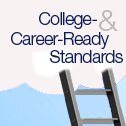An analysis of 1,500 classroom assignments given at six urban middle schools last year yielded some disappointing results: Just 4 in 10 assignments were found to meet the Common Core State Standards’ high bar for literacy. In high-poverty schools, the average was closer to 3 in 10.
The Education Trust, the research and advocacy think tank that conducted the study, is working to expand on those findings in the hopes of eventually helping schools ratchet up the rigor of classroom work.

At an event here Monday, about 200 K-12 educators, most of whom hailed from the District of Columbia and Maryland, convened to learn how to scrutinize assignments in their own schools and districts.
In an opening speech, Sonja Santelises, the vice president of K-12 policy and practice for the Education Trust, explained the rationale behind the focus on assignments. In pushing the common core, policymakers and practitioners “have said it’s important for the target to be more rigorous—[but] what’s the actual impact for kids everyday?” she asked. “It’s not because assignments in and of themselves change kids’ lives, but it’s because the compilation of assignments signals for our young people what we think of them, what we think they are capable of, what our expectation is, and what our commitment to get them there is.”
Kati Haycock, the organization’s CEO, set the stage by showing examples of the variation in the kinds of assignments students are given. She offered the following two tasks assigned to 7th grade English/language arts students—both in classrooms using the common-core standards.
Here’s one:

And another, less rigorous example:


The second task asks students to fill in their blanks based on their thoughts and feelings, rather than make an argument based on a text as the common-core emphasizes. “Low-level assignments [like the second one] can have a purpose ... in isolation,” Haycock said. “But think about the impact of assignments like these compounded over multiple assignments over multiple years.”
A Messy Process
Over the course of the day, the teachers and administrators used a rubric created by the Ed Trust to critique sample assignments. Some who brought along work from their own classrooms and schools looked at those tasks as well.
An exercise with the large group showed just how messy the process of determining whether an assignment meets the common-core benchmark can be.
The ballroom full of educators looked at an 8th grade history Socratic seminar activity that asked students to have a discussion about #BlackLivesMatter vs. #AllLivesMatter, based on several texts. The activity sheet provided a series of questions about the Black Lives Matter movement, historical civil rights leaders, and current events, which were meant to start a dialogue among students. In determining the level of “cognitive challenge” required by the task, the participants were not in agreement. Ed Trust had scored the assignment as meeting high levels of cognitive demand, but a show of hands indicated that only about half of the room would have scored it the same way. Some teachers argued that the assignment’s questions were worded in such a way that students could have answered them simply from their own experiences, without having done any outside reading.
“You can see there’s a lot that’s going to come up when you’re looking at an assignment,” Joan Dabrowski, a literacy consultant working with the Ed Trust who was leading the session, said to the crowd. “It’s the same as when you score writing assignments. You have to come to a place of calibration.”
Camille Anderson, a reading instructional coach at Ketcham Elementary School in the District of Columbia, was among those who disagreed with the Ed Trust score. However, she said in an interview that the subjective nature of the work certainly wouldn’t scare her off from having groups of teachers use the rubric at her school. “The idea of going through this process is great,” she said. “It’s about the investigation. ... It’s more important for me that teachers are challenging themselves by having those conversations.”
Expanding the Assignments Work
The rubric the teachers were using was just a draft—the Ed Trust plans to release the final copy and post it online for anyone to use sometime before the fall.
The Ed Trust will also release findings this fall on an analysis of middle school math assignments. (The first study looked only at how social studies, ELA, and science tasks met the literacy standards.) In addition to the six schools studied initially, nine more schools will be involved in that round of findings, according to Keith Dysarz, the director of K-12 practice. And the group will use feedback from the convening to ensure the rubric works not just for middle school, but for all grades.
And ultimately, the organization hopes to do more regional convenings like the one here this week. “Those messy discussions you saw in there—we had those same ones internally,” Dysarz said in an interview. “And we’re all richer and better for it. That, to me, is some of the best professional development a teacher can go through.”
Related stories:
